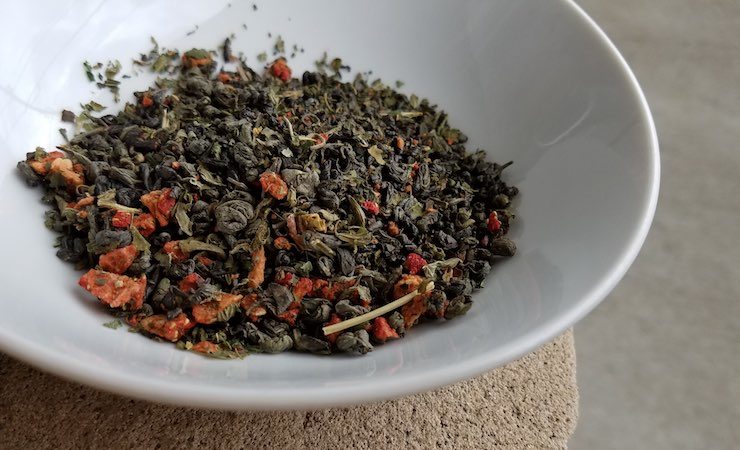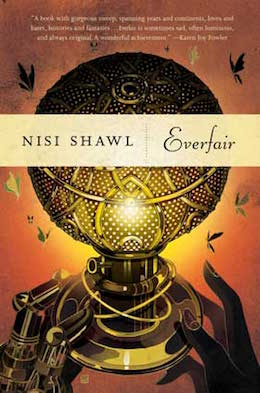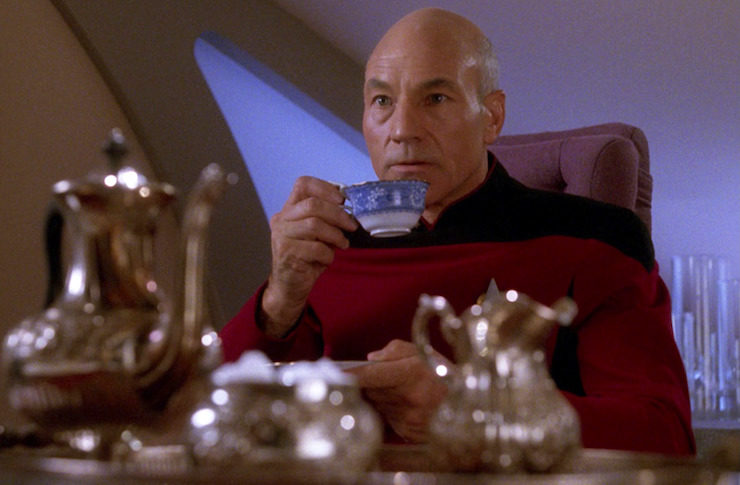In this ongoing series, we ask SF/F authors to describe a specialty in their lives that has nothing (or very little) to do with writing. Join us as we discover what draws authors to their various hobbies, how they fit into their daily lives, and how and they inform the author’s literary identity!
Steep: a word redolent of depths. I buy and dry and cut and stir together certain ingredients, then steep them. Drown them. Beneath just-boiled water they release their essences to mingle pleasingly.
For my work I write. For my play I blend teas.
I classify myself as a tea lover rather than a connoisseur, because the recipes for my blends are based on personal experiences and the emotions they arouse, not on knowledge. When I combine camellia leaves with heaps of flowers and pineapple pieces and bits of twice-baked vanilla beans, I do so with my heart as much as with my head.
Maria Velazquez started it all by giving me a green tea blend which was—at the time—commercially available. First she asked me a series of questions, matching my answers and preferences with her stock. Then she sent me the premium to which my Con or Bust donation entitled me: a pound of “Sunny Dreams.” When that pound ran out I ordered another from the manufacturer—only to learn that they no longer offered that particular concoction for sale.
So I tried to reconstruct it. What had made “Sunny Dreams” taste and look and smell so good? Why hadn’t it crisped my nerves to a frazzle when I drank a cup? My initial attempt was modestly successful, and with the second I got better, got closer to what I remembered liking. That gave me the courage to attempt more.
My current blend is “Pretty in Pink,” which combines gunpowder green, nettle, lemon balm, freeze-dried strawberries, basil, and vanilla. Here’s a photo:

My most complex blend, “Just Before the Dawn,” has eleven ingredients, including calendula petals, orange peel, rosehips, and two types of green tea: gunpowder and bancha. “A Tea Supreme” is a tribute to John Coltrane, of course, but also to the Yoruba deity Obatala, whose name means “owner of the white cloth.” The borage in this blend supports breath control, which was a key factor in Coltrane’s musicianship. The white tea base and the addition of white rose petals reinforce the religious element, and pears are sacred to Obatala, so I use them as “Supreme’s” sweetener.
Finding food-grade white roses was quite the quest. Pink roses are everywhere; for white, though, I expected to have to go to great lengths. And I did. I ordered a dozen from Brazil. Then U.S. Customs sprayed them at the border and turned their chemical signature utterly poisonous. Despair filled me till my friend Sabrina Chase offered to harvest the white roses growing on the viney arbor in her home’s side yard. There’s now a tiny bottle of their petals stashed in my cupboard to be used in “Supreme’s” next batch.
Relying on memories of working in food coops in the 1970s, I badly underestimated the difficulty of finding the dried pears I wanted for this blend, and when they came, they were too moist. I had to re-dry them. I’ve wound up doing the same with apples, peaches, mangoes—basically any fruit I use. Vanilla, too. Orange, lemon, and citron peel I create from scratch.
What I’m saying is, their production is far too labor intensive to make it worth my while to sell jars of “Because We Are All So Royal,” “Constantly Coming Woman,” etc. And the recipes themselves are too imprecise to monetize. They’re constructed by feel. “Nice tea collage,” Eileen Gunn remarked over a cup of “Three Is a Green Crown.” She hit the analogy on the head.
The only thing worth doing with my blends is to share them. People I love receive a few sachets of my latest blend in the mail whenever I devise a new one. I carry spare sachets with me to gift to fellow tea lovers I meet as I run errands and travel around the world.
A year ago I came up with a blend I call “Living Your Life Like It’s Golden,” in honor of the Jill Scott song of that title. I can tell you quantities for roughly half that blend’s ingredients; the rest you should just guess:
- 2 oz golden dragon tea (or any golden tea)
- .75 oz sencha green tea
- .25 oz nettle leaves
- some lemon balm
- some lemon verbena
- some saffron
- some calendula (marigold) flowers
- 5 vanilla beans
- 2 oz dried mango (or peach, if mango is an allergen for you)
- 2 cinnamon sticks
Bake the vanilla beans and cinnamon sticks for about half an hour at a really low temperature, like around 250. Let them cool and cut them up into extremely small pieces. Cut the mango up into similarly small pieces, then bake that, also, at a really low temperature.
Let the mango pieces cool, too, and then toss everything together by hand in a big ceramic or glass bowl until it’s thoroughly blended. Steep approximately one teaspoon of this mixture in 16 ounces of freshly boiled filtered water. Ideal steeping times will vary, but should run between three and five minutes.
Taste, and adjust the blend accordingly.
That’s the best I can do at transcribing one blend’s ingredients. Bring your own joy.
 Nisi Shawl is a writer of science fiction and fantasy short stories and a journalist. She is the author of Everfair (Tor Books, September 6) and co-author (with Cynthia Ward) of Writing the Other: Bridging Cultural Differences for Successful Fiction. Her short stories have appeared in Asimov’s SF Magazine, Strange Horizons, and numerous other magazines and anthologies.
Nisi Shawl is a writer of science fiction and fantasy short stories and a journalist. She is the author of Everfair (Tor Books, September 6) and co-author (with Cynthia Ward) of Writing the Other: Bridging Cultural Differences for Successful Fiction. Her short stories have appeared in Asimov’s SF Magazine, Strange Horizons, and numerous other magazines and anthologies.










